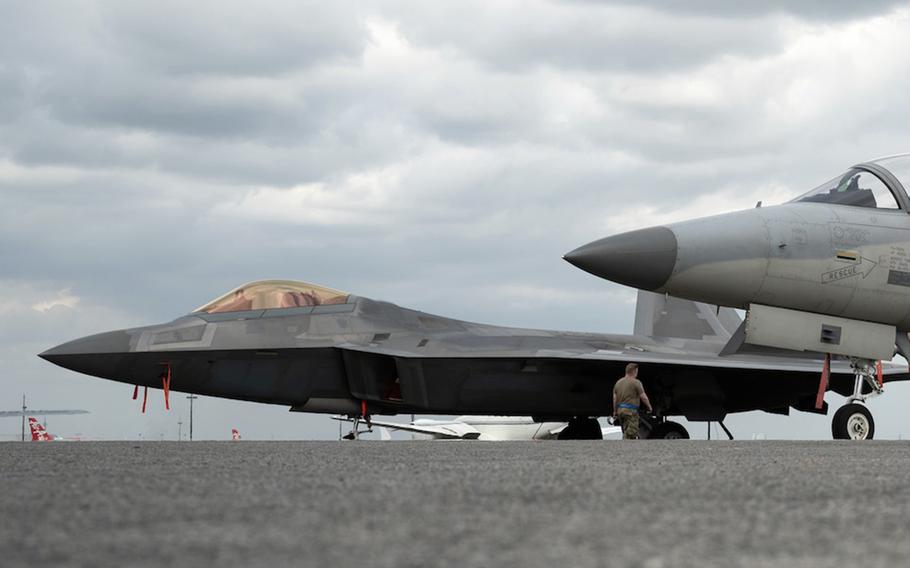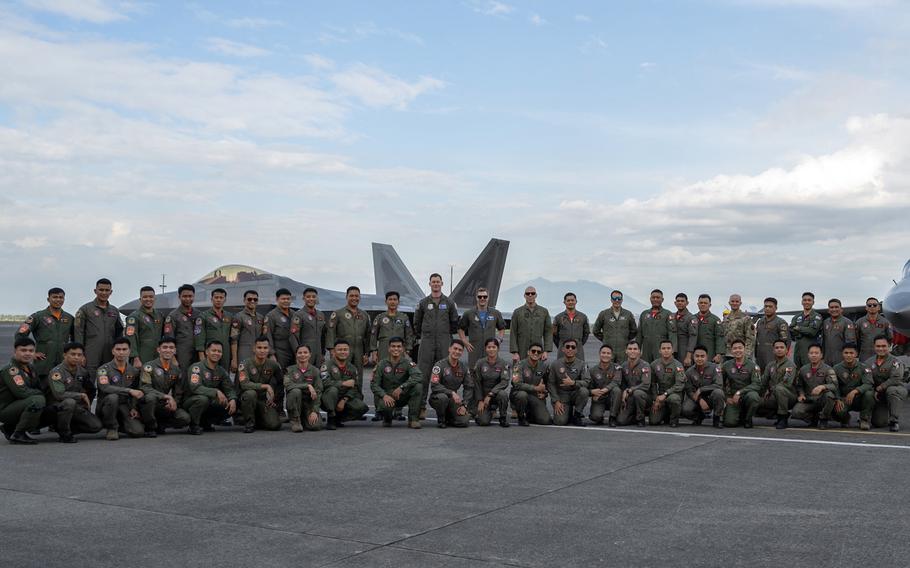
An Air Force F-22 Raptor, left, parks beside another jet at Clark Air Base, Philippines, in this photo tweeted by the. U.S. Embassy, Thursday, March 16, 2023. (U.S. Embassy in the Philippines)
U.S. Air Force F-22 Raptor stealth aircraft have been training out of a Philippine air base that was once part of America’s largest overseas military community.
Photographs of the Raptors – the first deployed by the Air Force to the Philippines – were tweeted Wednesday and Thursday by numerous accounts in the Philippines, including by the U.S. Embassy in Manila.
“For the first time in history, two F-22 ‘Raptor’ stealth fighter jets from @PACAF (Pacific Air Forces) landed at Clark Air Base to reinforce commitment to the Mutual Defense Treaty,” the embassy tweeted Thursday.
U.S. and Philippine pilots discussed training, aircraft capabilities and future collaboration, the embassy wrote.
The planes belong to the 525th Fighter Squadron at Joint Base Elmendorf-Richardson, Alaska, PACAF spokeswoman Capt. Allison Delury wrote in an email Friday to Stars and Stripes.
“This exchange emphasizes the strong military relationship between historic allies and confirms our commitment to our partnership with the Philippines,” she said.
The fifth-generation fighters are worth $143 million each and can fly more than twice the speed of sound with a range of more than 1,850 miles, according to the Air Force. Its inventory includes 183 of the air superiority fighters.

U.S. and Philippine airmen pose with an Air Force F-22 Raptor at Clark Air Base, Philippines, in this photo tweeted by the U.S. Embassy, Thursday, March 16, 2023. (U.S. Embassy in the Philippines)
Clark and nearby Subic Naval Base formed the largest U.S. overseas military community before both were damaged in the 1991 eruption of Mount Pinatubo and, soon after, returned to the Philippines.
Late last year, a pair of Japanese F-15J Eagle fighters visited Clark, the first time the Japan Air Self-Defense Force deployed its fighters to a member of the Association of Southeast Asian Nations, the service said in a Dec. 8 tweet.
Raptors from Tinian, near Guam, also took part in the Agile Reaper exercise, which recently concluded, according to an Air Force news release Wednesday.
The exercise, on Guam and Tinian, involved airmen from the 673rd Air Base Wing and 3rd Wing at Joint Base Elmendorf-Richardson, Alaska, the release said.
The training focused on agile combat employment, the ability to move aircraft rapidly to a network of smaller airfields in the Western Pacific to avoid being targeted by Chinese missiles in the event of war.
“I've told all the Wing Commanders, the numbered Air Force commanders and PACAF that I expect them to take risk,” Gen. Ken Wilsbach, Pacific Air Forces commander, said in the release. “I expect them to get better and better. They've got to be able to meet the mission taskings, all the communication, all that's required to be in the right place, at the right time, with your airpower. That’s why we have Raptors at Tinian, so that they can practice those skills.”
The F-22s involved in Agile Reaper were assigned to the 525th Expeditionary Fighter Squadron, which is deployed to Kadena Air Base, Japan, according to the news release.
The Air Force on Nov. 1 began a two-year phased withdrawal of two squadrons of F-15 Eagle fighters from Kadena. Alaska-based Raptors began a rotation at the base on Nov. 4.
The presence of advanced aircraft in the region demonstrates their potentially wider role, and the possibility of a permanent presence expressed in June by the head of the U.S. Indo-Pacific Command, Adm. John Aquilino.
“I would envision that that capability is certainly — well, it’s certainly desirable, but we would like to get to that,” he told the Foundation for Defense of Democracies, a think tank in Washington, D.C. “That ability to, like I said, operate in contested space, fifth-generation capabilities, whether they be F-22, F-35, are critically important to the ability to deliver deterrence.”
A permanent contingent of Air Force fifth-generation fighters west of the International Date Line is a “desirable” option as the U.S. seeks to deter an increasingly assertive China, Aquilino said.